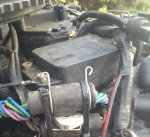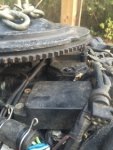The electrical system on the V6 crossflows was always a two-power pack system up through the 88 model year. In 1989, OMC changed to the single power pack. When this system came out some ignition parts changed, as the power pack logic changed. The 86-89 V6 models had been re-badged as a 175 hp engine, not the 235. Quickstart and SLOW features were added to the newer single power pack. Those engines also sported the 35 amp alternator which had the vented flywheel. Not sure just what different components your engine has, but yours does not have the vented flywheel. Not sure just what commonality your ignition system has with your stock 85 components. (spark plug coils are not a problem.) While the crank keyway is in the same position, I believe the vented flywheels that have quickstart have a different timing ring in the center of the flywheel. Your flywheel may or may not have the correct timing ring. You will have to run the engine to see if you get a timing rpm pickup when the engine is first started (cold) each day. Quick start will up the rpms to maybe 900-950 (from 650 idle) until the block reaches 92 degrees, then quickstart will cancel the spark advance and the engine's idle will return to the lower rpms. In 1989, OMC put the new single power pack on the 150 engines with the old-style solid flywheel. (10 amp charging system). Perhaps that's what is on yours. Make no mistake, none of these ignition systems are bad systems, just different. They will power your engine just fine. The only problem I have is that the early (1970's, early 80's) dual power packs had no rev limiters. Many of the later packs (both dual and the single) have built in 5800 rev limiters. That's not a performance feature for that engine-it's a restriction.





















